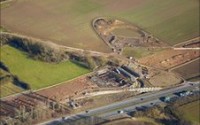The Roman Roadside Settlement at Healam Bridge, North Yorkshire
- Date
- 13 May 2014
- Start time
- 7:30 PM
- Venue
- Tempest Anderson Hall
- Speaker
- Richard Fraser

The Roman Roadside Settlement at Healam Bridge, North Yorkshire
A lecture by Richard Fraser, BA, Director, Northern Archaeological Associates
A joint event organised by YPS in association with the Yorkshire Archaeological Society, Roman Antiquities Section
During recent upgrading of a section of the A1 between Dishforth and Leeming, a major excavation was undertaken on part of the Roman roadside settlement site at Healam Bridge. The site lies on Dere Street at the point where it crossed Healam Beck, and covers an area of c.18ha. The excavated evidence suggests that it was probably a Hadrianic foundation, although Dere Street had been constructed slightly earlier. The settlement grew rapidly in the 2nd century AD, and after a period of contraction, saw significant renewed activity during the 4th/5th century AD.
Healam was one of the larger settlements in a region which contained few urban or semi-urban communities in the Roman period. Horses and mules represented an important part of its economy, and it is possible that the settlement was established to supply animals for transport. The site’s location between the two major towns probably made it a natural market centre.
Report
Located midway between Dishforth and Leeming on the A1 (the Great North Road, aka Dere Street) Northern Archaeology Associates excavated a substantial area of a Roman settlement in advance of the recent A1 road improvements. The area investigated includes the point where Healam Beck crosses the A1. Here an 18th-century bridge was built, possibly on earlier foundations.
The site was first identified in 1949 in an earlier phase of road improvements when the presence of a Roman fort was suggested. Geophysical survey confirmed the presence of a substantial, roughly rectilinear ditched enclosure with 140m sides to the north of the bridge. This area remains uninvestigated and was not affected by recent works.
Further geophysical survey and excavation north of the bridge revealed a series of well ordered large rectangular-post built structures sitting gable-end on Dere Street. Several kilns or corn drying ovens were located between the buildings suggesting that this part of the site was used for storage or light industry during the Roman occupation.
Either side of the beck soil conditions included damp anoxic alluvial deposits which had preserved inorganic and organic finds including 175 pointed wooden stakes, some knotty and bent, drawn from 9 kinds of native trees including oak, alder hazel and ash. Associated with these stakes were substantial deposits of dumped rubbish, showing systematic rubbish disposal relating to attempts to terrace the beckside. This area produced the skeleton on a small equid (horse or mule) and an assemblage of domestic animal bones typical of a Roman occupation site.
The area south of the bridge was less intensely occupied with small ditches and gullies suggesting paddocks, a few equid footprints were found filled with sand. More importantly 37 human inhumations and cremations were excavated. Many (50%) of these were the remains of babies (peri/neonatal burials). Adult burials included both extended and crouched individuals, at least one individual was buried wearing hobnailed boots.
Other interesting finds include a small piece of scale armour and a mid 2nd-century copper-alloy military diploma (c AD 140). These were presented to Roman soldiers on retirement from the army and conferred Roman citizenship to their holders. Coins and pottery indicate the site was occupied from the 1st to the 5th centuries AD.
In short, Richard Fraser presented an intriguing picture of the site, but many unanswered questions remain. Is there really a fort nearby, or was this a mansio with associated structures? The forthcoming publication should throw more light on these matters.
Andrew K. G. Jones